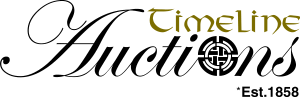Print page | Email lot to a friend
Back to previous pageLOT 0375
Sold for (Inc. bp): £45,720
MID-6TH-4TH CENTURY BC
11 3/4" (2.7 kg total, 30cm including stand).
A domed bronze helmet of Illyrian typology IIIA, variant 3, raised from a single sheet with cheek-pieces; two parallel raised ridges to the upper face with three incised lines; the smooth edges with a row of punched dots between narrow bands; short rear flange developing behind the curving cheek-protectors, each pierced for fastening of the chin-strap, one pierced with ferrous remains of a javelin tip(?) in situ, the other with a hole in corresponding place; square-cut frontal opening; button holes to the back of the neck-guard and a pierced hole at the front for attaching a crest; mounted on a custom-made display stand.
PROVENANCE:
Private collection, London, UK; acquired on the New York art market 22 May 2013; before that with Christie's, New York, 8 June 2012, lot 69 [US$40,000-$60,000]; previously in the private collection of Mr Thomson Murray Jr., USA, 1985; formerly in a private collection, Southern Germany, 1970s; accompanied by a report by military expert Dr. Raffaele D'Amato, and copies of the relevant Christie's catalogue pages; this lot has been checked against the Interpol Database of stolen works of art and is accompanied by AIAD certificate number no.10806-178695.
LITERATURE:
See Pflug, H., 'Illirysche Helme' in Antike Helme, RGZM Monographien 14, Mainz, 1988, pp. 43-64; Connolly, P., Greece and Rome at war, London, 1981; Christie's, The Axel Guttmann Collection of Ancient Arms and Armour, part 1, London, 2002; Christie's, The Axel Guttmann Collection of Ancient Arms and Armour, part 2, London, 2004; Vasić, R., ‘Reflecting on Illyrian helmets’, in Starinar, LX, Belgrade, 2010, pp.37-55; for an example of similar helmets see Guttman collection (Christie's, 2002, no.52; 2004, p.80, nos.69,73) which shows the same long cheek-pieces and short rear flange.
FOOTNOTES:
The so-called Illyrian helmets, with a rectangular opening for the face, triangular or elongated cheek-pieces and a neck guard, as well as a track consisting of two ridges on the top of the crown for the crest, are archeologically distributed over a large territory – from the Balkan Peninsula, Greece, Italy and along the Adriatic Coast, and as far as the Black Sea region, creating a great diversity of forms, with various types or subtypes. The most widespread and most popular was the late form – Type III, which developed from Type II and dates from the second half of the 6th to the 4th century BC. Its division into Types IIIA with side gussets (‘Seitenzwickeln’, Pflug, 1988, p.52) and IIIB with a round opening cut for the ears is generally accepted. In our type IIIA it is interesting to note the presence of an extraneous iron body which pierced the right cheek-guard, maybe the tip of a javelin that could have caused the death of the wearer.





